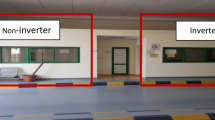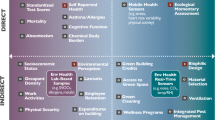Abstract
Building performance simulation (BPS) tools need valid emission models to quantify the effects building generated pollution has on indoor air quality (IAQ) and energy demand. Predictions from existing emission models for volatile organic compounds have been shown not to correspond well with real world observations. This study aimed to approximate the impact building generated pollution has on the energy demand of Danish homes fitted with balanced mechanical ventilation systems using heat recovery. Two emission models were developed by regression analysis: one for normal level and one for high level formaldehyde (HCHO) emission rates. Data came from measurements done in detached and semi-detached homes in rural or sub-urban Denmark. Analysis included temperature, humidity and air changes per hour (ACH) as possible predictor variables. ACH was found to be the most important predictor. The emission models were implemented into a validated BPS tool, IDA ICE. Simulations showed it was necessary to have an ACH of minimum 0.22 h-1 to safeguard against HCHO. Two control strategies could prevent harmful levels of HCHO: a base level ventilation rate of 0.3 L/(s-m2) and a demand controlled ventilation (DCV) system using HCHO as a control variable. The DCV systems with heat recovery improved IAQ and reduced energy demand up to 3% seen relative to constant air volume ventilation systems with heat recovery. Based on considerations of the current level of technology and pricing, it was recommended to continue the current practice of prescribing base ventilation rates. Still, building generated pollution deserves continued attention.
Similar content being viewed by others
References
Andersen I, Lundqvist GR, Mølhave L (1975). Indoor air pollution due to chipboard used as a construction material. Atmospheric Environment (1967), 9: 1121–1127.
Bekö G, Lund T, Nors F, Toftum J, Clausen G (2010). Ventilation rates in the bedrooms of 500 Danish children. Building and Environment, 45: 2289–2295.
Bekö G, Gustavsen S, Frederiksen M, Bergsøe NC, Kolarik B, Gunnarsen L, Toftum J, Clausen G (2016). Diurnal and seasonal variation in air exchange rates and interzonal airflows measured by active and passive tracer gas in homes. Building and Environment, 104: 178–187.
BSI (2007). EN 15251:2007 - Indoor environmental input parameters for design and assessment of energy performance of buildings addressing indoor air quality, thermal environment, lighting and acoustics. Technical Committee CEN/TC 156 “Ventilation for buildings”, British Standards.
Chung P-R, Tzeng C-T, Ke M-T, Lee C-Y (2013). Formaldehyde gas sensors: A review. Sensors, 13: 4468–4484.
Danish Building Regulations (2018). Danish Building Regulations 2018. Denmark: The Danish Transport, Construction and Housing Authority.
Danish Construction Association (2017). Byggeriets Energianalyse 2017. Copenhagen, Denmark: The Danish Construction Association. (in Danish)
Danish Working Environment Authority (2018). Indoor Climate Guideline. Available at https://arbejdstilsynet.dk/da/regler/at-vejledninger/i/a-l-2-indeklima. Accessed 10 May 2018.
Dimitroulopoulou C (2012). Ventilation in European dwellings: A review. Building and Environment, 47: 109–125.
Dodoo A, Gustavsson L, Sathre R (2011). Primary energy implications of ventilation heat recovery in residential buildings. Energy and Buildings, A3: 1566–1572.
EIA (2018). How much energy is consumed in U.S. residential and commercial buildings? U.S. Energy Information Administration. Available at https://www.eia.gov/tools/faqs/faq.php?id=86&t=1. Accessed 16 Mar 2018.
European Commission on Energy Efficiency in Buildings (2018). Available at https://ec.europa.eu/energy/en/topics/energy-efficiency/buildings. Accessed 16 Mar 2018.
Goel S, Rosenberg MI, Eley C (2017). ANSI/ASHRAE/IES Standard 90.1-2016 Performance Rating Method Reference Manual. Office of Scientific and Technical Information (OSTI).
Guyot G, Sherman MH, Walker IS (2018). Smart ventilation energy and indoor air quality performance in residential buildings: A review. Energy and Buildings, 165: 416–430.
Hoetjer JJ, Koerts F (1986). A model for formaldehyde release from particleboard. In: Meyer B, Kottes Andrews BA, Reinhardt RM (eds), Formaldehyde Release from Wood Products, Washington DC: ACS Publications. pp. 125–144.
Hopke PK (2015). Air pollution and health effects. In: Nadadur SS, Hollingsworth JW (eds), Molecular and Integrative Toxicology. London: Springer.
Huang S, Xiong J, Zhang Y (2015). Impact of temperature on the ratio of initial emittable concentration to total concentration for formaldehyde in building materials: Theoretical correlation and validation. Environmental Science & Technology, 49: 1537–1544.
Huang S, Xiong J, Cai C, Xu W, Zhang Y (2016). Influence of humidity on the initial emittable concentration of formaldehyde and hexaldehyde in building materials: experimental observation and correlation. Scientific Reports, 6: 23388.
Hult EL, Willem H, Price PN, Hotchi T, Russell ML, Singer BC (2015). Formaldehyde and acetaldehyde exposure mitigation in US residences: In-home measurements of ventilation control and source control. Indoor Air, 25: 523–535.
IDA ICE (2018). IDA Indoor Climate and Energy. Available at https://www.equa.se/en/ida-ice. Accessed 13 May 2018.
Johnston CJ, Nielsen TR, Toftum J (2019). Comparing predictions by existing explicit emission models to real world observations of formaldehyde emissions. Building Simulation, https://doi.org/10.1007/s12273-019-0567-8
Kolarik B, Gunnarsen L, Punch LW (2010). Afgivelse af formaldehyd fra byggevarer og forbrugerprodukter. The State Building Research Institute. (in Danish)
Kumar P, Skouloudis AN, Bell M, Viana M, Carotta MC, Biskos G, Morawska L (2016). Real-time sensors for indoor air monitoring and challenges ahead in deploying them to urban buildings. Science of the Total Environment, 560-561: 150–159.
Laverge J, Janssens A (2012). Heat recovery ventilation operation traded off against natural and simple exhaust ventilation in Europe by primary energy factor, carbon dioxide emission, household consumer price and exergy. Energy and Buildings, 50: 315–323.
Lehmann WF (1987). Effect of ventilation and loading rates in large chamber testing of formaldehyde emissions from composite panels. Forest Products Journal 37: 31–37.
Liang W, Yang S, Yang X (2015). Long-term formaldehyde emissions from medium-density fiberboard in a full-scale experimental room: emission characteristics and the effects of temperature and humidity. Environmental Science & Technology, 49: 10349–10356.
Liang W, Lv M, Yang X (2016). The combined effects of temperature and humidity on initial emittable formaldehyde concentration of a medium-density fiberboard. Building and Environment, 98: 80–88.
Logadóttir A, Gunnarsen L (2008). Formaldehydkoncentrationen i nybyggede huse i Danmark. The State Building Research Institute. (in Danish)
Mata E, Sasic Kalagasidis A, Johnsson F (2013). Energy usage and technical potential for energy saving measures in the Swedish residential building Stock. Energy Policy, 55: 404–414.
Morrison G (2015). Recent advances in indoor chemistry. Renewable Energy Reports, 2: 33–40.
Myers GE, Nagaoka M (1981). Emission of formaldehyde by particleboard: effect of ventilation rate and loading on air-contamination levels. Forest Products Journal, 31: 39–44.
Offermann FJ, Maddalena R, Offermann JC, Singer BC, Wilhelm H (2012). The impact of ventilation on the emission rates of volatile organic compounds in residences. In: Proceedings of the 10th International Conference on Healthy Buildings, Brisbane, Australia.
Qian K, Zhang Y, Little JC, Wang X (2007). Dimensionless correlations to predict VOC emissions from dry building materials. Atmospheric Environment, 41: 352–359.
Rackes A, Waring MS (2016). Do time-averaged, whole-building, effective volatile organic compound (VOC) emissions depend on the air exchange rate? A statistical analysis of trends for 46 VOCs in US offices. Indoor Air, 26: 642–659.
Rim D, Gall ET, Maddalena RL, Nazaroff WW (2016). Ozone reaction with interior building materials: Influence of diurnal ozone variation, temperature and humidity. Atmospheric Environment, 125: 15–23.
Salthammer T, Mentese S, Marutzky R (2010). Formaldehyde in the indoor environment. Chemical Reviews, 110:2536–2572.
Salthammer T (2015). The formaldehyde dilemma. International Journal of Hygiene and Environmental Health, 218: 433–436.
Schieweck A, Uhde E, Salthammer T, Salthammer LC, Morawska L, Mazaheri M, Kumar P (2018). Smart homes and the control of indoor air quality. Renewable and Sustainable Energy Reviews, 94: 705–718.
Stymne H, Axel Boman C, Kronvall J (1994). Measuring ventilation rates in the Swedish housing Stock. Building and Environment, 29: 373–379.
Tenwolde A, Pilon CL (2007). The effect of indoor humidity on water vapor release in homes. In: Proceedings of the International Conference on Thermal Performance of Exterior Envelopes of Whole Buildings.
Tommerup H, Svendsen S (2006). Energy savings in Danish residential building stock. Energy and Buildings, 38: 618–626.
Waring MS (2014). Secondary organic aerosol in residences: predicting its fraction of fine particle mass and determinants of formation strength. Indoor Air, 24: 376–389.
Weschler CJ (2009). Changes in indoor pollutants since the 1950s. Atmospheric Environment, 43: 153–169.
Weschler CJ (2011). Chemistry in indoor environments: 20 years of research. Indoor Air, 21: 205–218.
WHO (2010). WHO Guidelines for Indoor Air Quality—Selected pollutants. Copenhagen, Denmark: WHO Regional Office for Europe.
Xiong J, Wei W, Huang S, Zhang Y (2013). Association between the emission rate and temperature for chemical pollutants in building materials: General correlation and understanding. Environmental Science & Technology, 47: 8540–8547.
Xu J, Zhang J, Liu X, Gao Z (2012). Determination of partition and diffusion coefficients of formaldehyde in selected building materials and impact of relative humidity. Journal of the Air & Waste Management Association, 62: 671–679.
Xu Y, Zhang J (2011). Understanding SVOCs. ASHRAE Journal, 53(12): 121–125.
Ye W, Won D, Zhang X (2014). A preliminary ventilation rate determination methods study for residential buildings and offices based on VOC emission database. Building and Environment, 79: 168–180.
Ye W, Won D, Zhang X (2015). A simple VOC prioritization method to determine ventilation rate for indoor environment based on building material emissions. Procedia Engineering, 121: 1697–1704.
Zhang Y, Xiong J, Mo J, Gong M, Cao J (2016). Understanding and controlling airborne organic compounds in the indoor environment: Mass transfer analysis and applications. Indoor Air, 26: 39–60.
Zhang J, Song F, Tao J, Zhang Z, Shi S (2018). Research progress on formaldehyde emission of wood-based panel. International Journal of Polymer Science, 2018: 1–8.
Acknowledgements
We would like to thank Ásta Logadóttir, PhD, Senior Researcher, Danish Building Research Institute, Aalborg University and Professor Lars Gunnarsen, PhD, Danish Building Research Institute, Aalborg University for collecting and sharing the data on HCHO concentration levels in Danish homes.
Author information
Authors and Affiliations
Corresponding author
Electronic Supplementary Material (ESM)
Rights and permissions
About this article
Cite this article
Johnston, C.J., Andersen, R.K., Toftum, J. et al. Effect of formaldehyde on ventilation rate and energy demand in Danish homes: Development of emission models and building performance simulation. Build. Simul. 13, 197–212 (2020). https://doi.org/10.1007/s12273-019-0553-1
Received:
Revised:
Accepted:
Published:
Issue Date:
DOI: https://doi.org/10.1007/s12273-019-0553-1




